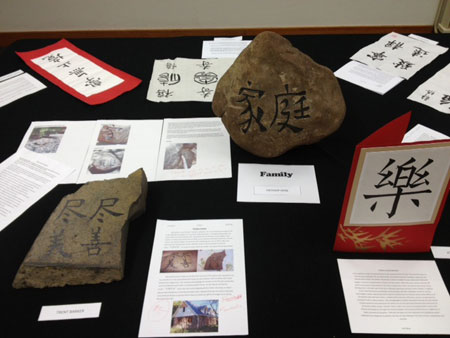Students Nurture the Heart and Soul through Chinese Calligraphy
Thirty-four students at the University of New England (Australia) have created works of art in one of the most revered of Chinese artistic traditions. They have done so after practicing the art of Chinese calligraphy for just three months.
«I’m so proud to be the teacher of these talented young people,» says Dr Shi Li, professor of Chinese at UNE. Dr Li is continuing the work of a former UNE professor, Dr Cuncun Wu, who initiated the teaching of Chinese calligraphy at the University. In talking about the cross-cultural appeal of this art form, he pointed out that the majority of the students were of non-Chinese background, and that the best of the works had come from among them. «So Chinese background doesn’t matter,» he said.
And knowledge of the Chinese language is not essential either, as half of the calligraphy students are not students of Chinese. The most important thing, said Dr Li, is emotional equanimity. «If your breathing isn’t calm you can’t hold the brush steadily,» he said. And in fostering such equanimity, the practice of calligraphy «nurtures the heart and soul».
At the opening ceremony of an exhibition of the students’ work, Professor Darryl Poulsen, Head of UNE’s School of Arts, emphasized the «aesthetic appeal» of Chinese calligraphy, and pointed out that UNE was one of the very few universities in Australia teaching this art.
For one of the students — Ishtar Welstead — its aesthetic appeal was one of the aspects of calligraphy that attracted her. And, as a student of Japanese, many of the characters were familiar to her. She also mentioned the importance of the physical and emotional aspects of the art. «It might surprise you just how much control is involved,» she said. It could be the beginning of a journey of discovery for Ishtar. «I believe I can continue doing calligraphy into the future,» she said.
The students have painted — and chiseled — their Chinese characters onto a variety of materials, including cards, scrolls, leaves and rocks. Frithjof Herb, for example, has chiseled the characters for «family» into a large rock that he discovered on his family’s property, and Trent Barker has painted characters onto one of the stones that he and his father collected to build their house.

The work of Frithjof Herb (centre), Trent Barker (upper left corner)
and Joshua Skow (upper right corner)
Source:
Man′s beauty is in the beauty of his writing.



